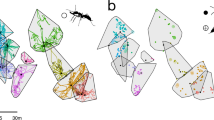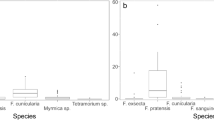Abstract
Ant colonies can reproduce by two strategies: independent foundation, wherein the queen starts a new colony alone, and dependent foundation, in which workers assist the queen. In the queenless species Dinoponera quadriceps (Santschi), the colony reproduces obligatorily by fission, a type of dependent foundation, but this process is not well understood. This study describes a colony fission event of D. quadriceps in the field and analyzes the influence of the fission process on workers’ extra-nest behavior. Based on observations of workers outside the nest, five distinct stages were identified: monodomic stage, polydomic stage, split stage, conflict stage, and post-conflict stage. The colony was initially monodomic and then occupied a second nest before it split into two independent colonies, indicating a gradual and opportunistic dependent foundation. After the fission event, the daughter colony had aggressive conflicts with the parental colony, resulting in the latter’s disappearance. Colony fission affected workers’ extra-nest behavior by increasing the frequency of rubbing the gaster against the substrate (which probably has a chemical marking function) and by decreasing the frequency of foraging during the split stage. After the fission event, the number of foragers was halved and foragers remained nearer to the nest during extra-nest activity. The spatial closeness of the parental and daughter colonies led to competition that caused the extinction or migration of the parental colony. Intraspecific competition was indicated by foraging directionality at the colony level, whereby areas of neighbor colonies were avoided; this directionality was stronger while both colonies coexisted.


Similar content being viewed by others
References
Altmann J (1974) Observational study of behavior: sampling methods. Behav 49:227–267
Araújo A, Rodrigues Z (2006) Foraging behavior of the queenless ant Dinoponera quadriceps Santschi (Hymenoptera: Formicidae). Neotropical Entomol 35:159–164
Azevedo DLO (2009) O papel das rotas e da obtenção de informações sobre a eficiência no forrageio de Dinoponera quadriceps em ambiente natural. Masters Thesis. Universidade Federal do Rio Grande do Norte, Natal, Brasil, p 86
Bourke AFG, Franks NR (1995) Social evolution in ants. Princeton University Press, Princeton, p 550
Cogni R, Oliveira PS (2004) Patterns in foraging and nesting ecology in the neotropical ant, Gnamptogenys moelleri (Formicidae, Ponerinae). Insectes Sociaux 51:123–130
Corbara B, Fresneau D, Lachaud J-P, Leclerc Y, Goodall G (1986) An automated photographic technique for behavioural investigations of social insects. Behav Process 13:237–249
Cronin AL, Molet M, Doums C, Monnin T, Peeters C (2013) Recurrent evolution of dependent colony foundation across eusocial insects. Annu Rev Entomol 58:37–55
Fourcassié V, Oliveira PS (2002) Foraging ecology of the giant Amazonian ant Dinoponera gigantea (Hymenoptera, Formicidae, Ponerinae): activity schedule, diet and spatial foraging patterns. J Nat Hist 36:2211–2227
Hart AG, Ratnieks FLW (2005) Crossing the taxonomic divide: conflict and its resolution in societies of reproductively totipotent individuals. J Evol Biol 18:383–395
Hölldobler B, Wilson EO (1990) The ants. Harvard University Press, Cambridge, p 732
Kempf WW (1971) A preliminary reviem of the ponerine ant genus Dinoponera Roger (Hymenoptera, Formicidae). Stud Entomol 14:369–392
Knaden M, Wehner R (2003) Nest defense and conspecific enemy recognition in the desert ant Cataglyphis fortis. J Insect Behav 16:717–730
Lenhart PA, Dash ST, Mackay WP (2013) A revision of the giant Amazonian ants of the genus Dinoponera (Hymenoptera, Formicidae). J Hymenopt Res 31:119–164
Levings SC (1983) Seasonal, annual, and among-site variation in the ground ant community of a deciduous tropical forest: some causes of patchy species distributions. Ecol Monogr 53:435–455
Levings SC, Traniello JFA (1981) Territoriality, nest dispersion, and community structure in ants. Psyche 88:265–320
Macedo RHF (2006) Cooperação animal. In: Yamamoto ME, Volpato GL (eds) Comportamento animal. EDUFRN – Editora da UFRN, Natal, pp 141–155
Martin P, Bateson P (1994) Measuring behavior: an introductory guide, 2nd edn. Cambridge University Press, Cambridge, p 222
Medeiros J, Araújo A, Araújo HPF, Queiroz JPC, Vasconcellos A (2012) Seasonal activity of Dinoponera quadriceps (Formicidae, Ponerinae) in the semi-arid Caatinga of NE Brazil. Rev Bras Entomol 56:81–85
Monnin T, Malosse C, Peeters C (1998) Solid-phase microextraction and cuticular hydrocarbon differences related to reproductive activity in queenless ant Dinoponera quadriceps. J Chemic Ecol 24:473–490
Monnin T, Peeters C (1997) Cannibalism of subordinates’ eggs in the monogynous queenless ant Dinoponera quadriceps. Naturwissenschaften 84:499–502
Monnin T, Peeters C (1998) Monogyny and regulation of worker mating in the queenless ant Dinoponera quadriceps. Anim Behav 55:299–306
Monnin T, Peeters C (2008) How many gamergates is an ant queen worth? Naturwissenschaften 95:109–116
Paiva RVS, Brandão CRF (1995) Nests, worker population, and reproductive status of workers, in the giant queenless ponerine ant Dinoponera Roger (Hymenoptera Formicidae). Ethol Ecol Evol 7:297–312
Peeters C, Ito F (2001) Colony dispersal and the evolution of queen morphology in social Hymenoptera. Annu Rev Entomol 46:601–630
Ryti RT, Case TJ (1988) Field experiments on desert ants: testing for competition between colonies. Ecol 69:1993–2003
Soroker V, Lucas C, Simon T, Fresneau D, Durand JL, Hefetz A (2003) Hydrocarbon distribution and colony odour homogenisation in Pachycondyla apicalis. Insectes Sociaux 50:212–217
Turchin P, Odendaal FJ, Rausher MD (1991) Quantifying insect movement in the field. Environ Entomol 20:955–963
Vasconcellos A, Santana GG, Souza AK (2004) Nest spacing and architecture, and swarming of males of Dinoponera quadriceps (Hymenoptera, Formicidae) in a remnant of the Atlantic forest in northeast Brazil. Braz J Biol 64:357–362
Wenseleers T, Billen J, Hefetz A (2002) Territorial marking in the desert ant Cataglyphis niger: does it pay to play bourgeois? J Insect Behav 15:85–93
Acknowledgments
We thank A. Vasconcellos from Universidade Federal da Paraíba and D. L. O. Azevedo, W. T. Hattori, and A. Cabral from Universidade Federal do Rio Grande do Norte for helpful suggestions on the manuscript. We also thank the Instituto Chico Mendes de Conservação da Biodiversidade for permission to work at Floresta Nacional de Nísia Floresta. Financial support was provided to J. Medeiros and A. Araújo (Grant #303466/2012-0) by the Conselho Nacional de Desenvolvimento Científico e Tecnológico.
Author information
Authors and Affiliations
Corresponding author
Additional information
Edited by Kleber Del Claro – UFU
Rights and permissions
About this article
Cite this article
Medeiros, J., Araújo, A. Workers’ Extra-Nest Behavioral Changes During Colony Fission in Dinoponera quadriceps (Santschi). Neotrop Entomol 43, 115–121 (2014). https://doi.org/10.1007/s13744-013-0193-6
Received:
Accepted:
Published:
Issue Date:
DOI: https://doi.org/10.1007/s13744-013-0193-6




